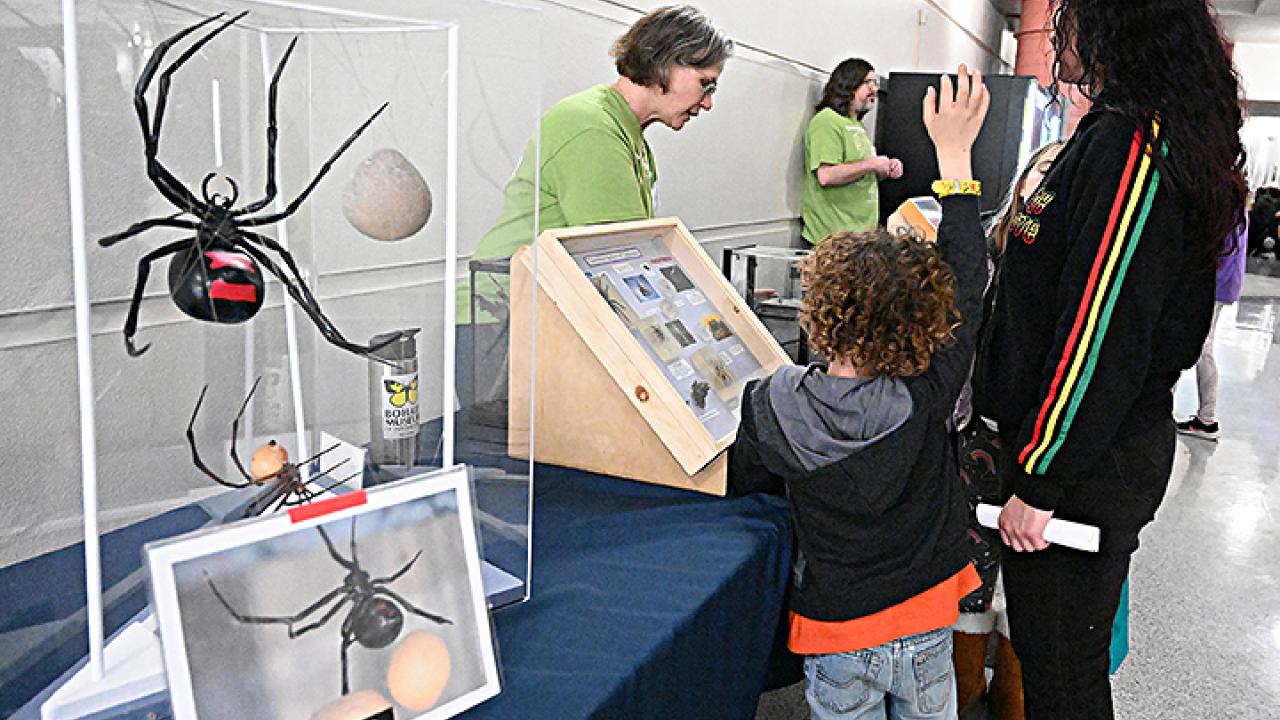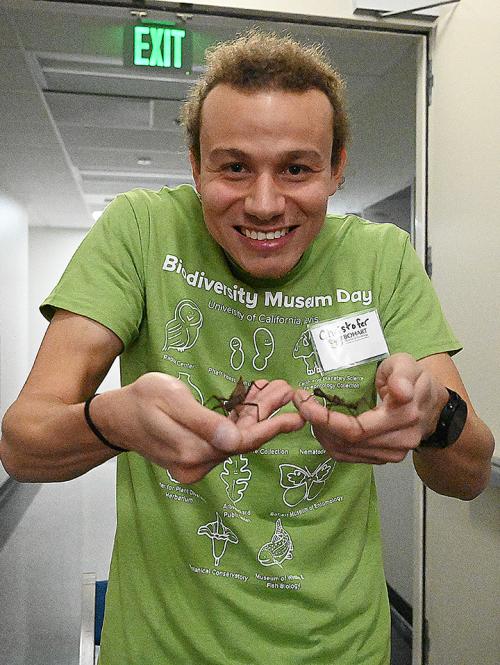
Bohart Museum of Entomology Gearing Up for UC Davis Biodiversity Museum Day
See Butterfly and Beetle Specimens, Pet a Stick Insect, Talk to the Scientists

The Bohart Museum of Entomology will showcase scores of specimens, its scientists and their research projects, its petting zoo--and more--at the 13th annual UC Davis Biodiversity Museum Day on Saturday, Feb. 10. Also known as "Super Science Day," the event will spotlight 10 museums or collections. It is free and family friendly.
The Bohart Museum activities will take place not only in Room 1124 of the Academic Surge Building, 455 Crocker Lane, but in the hallway. Special attractions in Room 1124 will be Lepidoptera and beetle collections.
"In the hallway, we'll have some 15 stations," said Tabatha Yang, education and outreach coordinator for the museum, and the chair of the Biodiversity Museum Day.
Professor Jason Bond, the Evert and Marion Schlinger Endowed Chair, UC Davis Department of Entomology and Nematology (ENT), and associate dean of the UC Davis College of Agricultural and Environmental Sciences, directs the Bohart Museum, succeeding UC Davis distinguished professor Lynn Kimsey, museum director from 1999 until her retirement last week.
Stations in the hallway will feature arachnids from the Bond lab; ants from the lab of ENT professor Phil Ward; and native bee displays from the labs of Rachel Vannette, associate professor and vice chair of the department; and Santiago Ramirez, associate professor, Department of Evolution and Ecology.
“The ant display will highlight the diversity, behavior, and ecological significance of ants (Hymenoptera: Formicidae), the world’s most successful group of social insects,” said Ward. “We will have specimens and images of army ants, seed-harvesting ants, carpenter ants, leafcutter ants, and assorted others, including the world’s smallest and largest ant workers.
Said Ramirez: “We are planning an exhibit that showcases the diversity of tropical orchid bees. The exhibit include a collection of pinned specimens and a stereomicroscope for the public to observe the bees under high magnification, we will also present a wide range of videos of bee development and bee behavior (social behavior, nest construction, egg laying, etc.).”
Also in the hallway will be skill stations, four “Oh My” drawer stations, and insect handling stations, where visitors can hold Madagascar hissing cockroaches and stick insects (walking sticks).
The Bohart Museum, founded in 1946 by ENT Professor Richard “Doc” Bohart, houses a global collection of eight million insect specimens. It is the seventh largest insect collection in North America. It also has an insect-themed gift shop stocked with T-shirts, hooded sweatshirts, books, posters, jewelry, pens and pins, as well as insect collecting equipment.
"The UC Davis Biodiversity Museum Day is a way for the dozen or so biological collections on this campus to work together to communicate to the public what it is we do and why biodiversity and the history of life on Earth is important,” commented Yang, the co-founder of the campuswide event.
The 10 museums or collections participating in Biodiversity Museum Day and the hours open are:
- Anthropology Museum, 328 Young Hall and grounds, open from noon to 4 p.m.
- Arboretum and Public Garden, Habitat Gardens in the Environmental GATEway, adjacent to the Arboretum Teaching Nursery on Garrod Drive, 10 a.m. to 2 p.m.
- Bohart Museum of Entomology, Room 1124 and main hall of the Academic Surge Building, 455 Crocker Lane, 10 a.m. to 2 p.m.
- Botanical Conservatory, the greenhouses along Kleiber Hall Drive, 10 a.m. to 2 p.m.
- California Raptor Center, 1340 Equine Lane, off Old Davis Road, 9 a.m. to 3 p.m.
- Center for Plant Diversity, Katherine Esau Science Hall off Kleiber Hall Drive, 10 a.m. to 2 p.m.
- Nematode Collection (part of the UC Davis Department of Entomology and Nematology), Katherine Esau Science Hall, off Kleiber Hall Drive, 10 am. to 2 p.m.
- Museum of Wildlife and Fish Biology, Room 1394, Academic Surge Building, 455 Crocker Lane, 10 a.m. to 2 p.m.
- Paleontology Collection, Department of Earth and Planetary Sciences, 1309 Earth and Physical Sciences Building, 434 LaRue Road, 10 a.m. to 2 p.m.
- Phaff Yeast Culture Collection, Robert Mondavi Institute Brewery and Food Processing facility, Old Davis Road, 10 a.m. to 2 p.m.
The public can download a map on the UC Davis Biodiversity Museum website that shows the locations of the 10 museums and collections, where food is available for purchase, and where parking is free. (See Bug Squad blog for brief information about each of the 10 museums and collections.)
